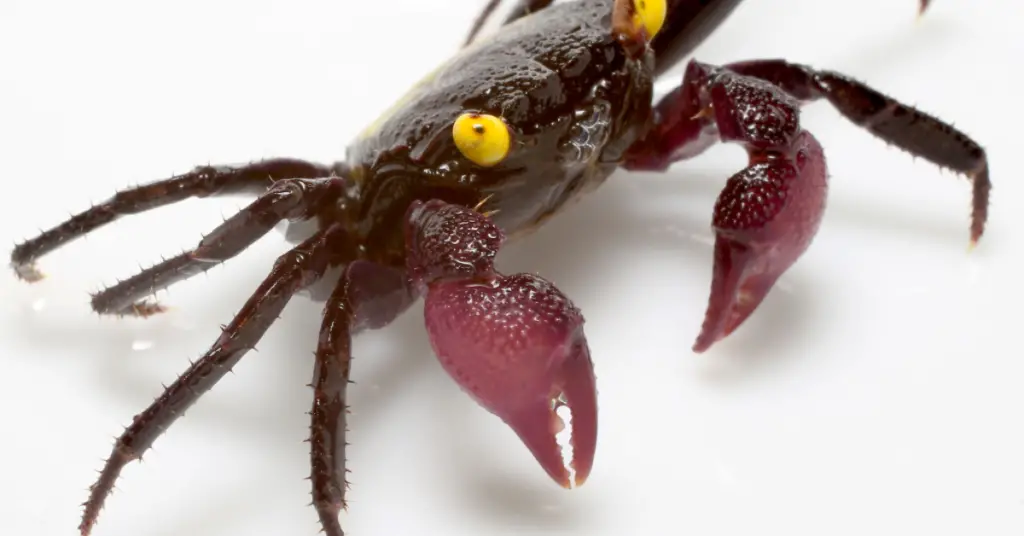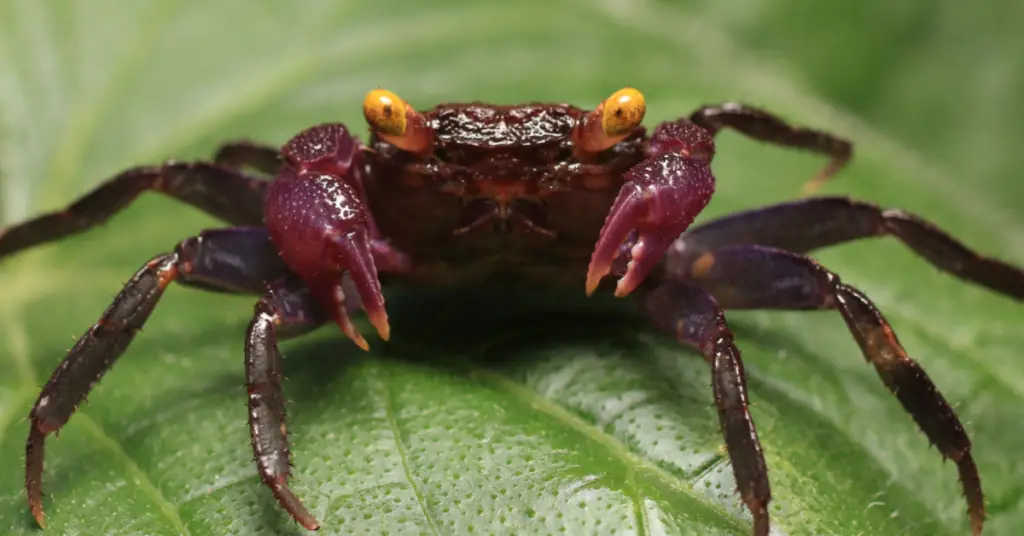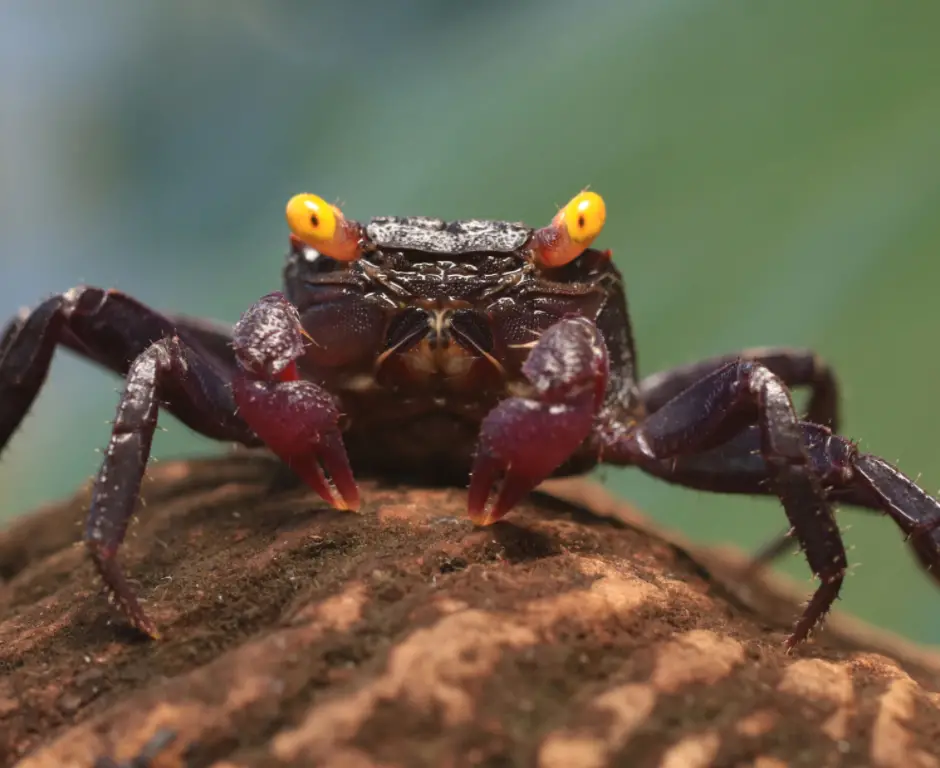I’m excited to share with you my knowledge and experience on caring for Vampire Crabs. These unique creatures are a great addition to any aquarium but require specific care to thrive.
In this guide, I’ll cover everything from their appearance and habitat requirements to feeding, breeding, and disease prevention. If you’re looking for an eye-catching creature that will add some intrigue to your tank, look no further than the Vampire Crab.
With their dark purple coloration and striking yellow eyes, these small semi-terrestrial crabs will captivate anyone who sees them. But beyond just their appearance, Vampire Crabs also have fascinating behavior and social dynamics that make them a joy to observe.
Overview and Appearance
You’re probably curious about what these creatures look like and how they should be set up in their new home, so let’s talk about the Vampire Crab’s appearance and the ideal tank setup!
These crabs are native to Indonesia, living in rocky caves near freshwater streams. To mimic this environment in captivity, a paludarium-style aquarium is recommended. This means that approximately 2/3 of the layout should be land, with a sandy terrestrial area complete with roots, plants, and rocky caves.
The Vampire Crab has a unique dark purple coloration with yellow eyes and white spots on its carapace. They have an average size of 2 inches wide and are sexually dimorphic – females have wider, oval pleons while males have narrow tapering pleons and larger claws.
It is important to note that these crabs can be aggressive towards other creatures, so keeping them in groups with other vampire crabs or small fast-swimming peaceful freshwater fish is best. An ideal tank size for a group would be at least 10 gallons with an 80/20 land to water ratio.
Breeding methods for Vampire Crabs are not well-established but generally breed on their own time. After fertilization, females will carry between 20-80 eggs for about a month under their abdomen before hatching into young who become proportionally more terrestrial as they mature.
If you plan on breeding your Vampire Crabs, it’s important to provide plenty of hiding spots for the young as they can display cannibalistic behavior towards each other.

Habitat and Care Requirements
To create a comfortable living space for your new semi-terrestrial pet, it’s important to set up a paludarium with extensive above-water areas for climbing and a water area that is heated and filtered. Mimicking the natural habitat of the Vampire Crab will help ensure their health and happiness in captivity. The natural habitat of the Vampire Crab consists of rocky caves and small burrows near freshwater streams in rainforest valleys in Indonesia.
When setting up the tank, make sure to have approximately 2/3 of the layout as land and 1/3 as water, with a land-to-water ratio of 80/20. A tight-fitting lid is essential to prevent escape since these crabs are known to climb out of open tanks. The terrestrial area should be sandy with roots, plants, and rocky caves for hiding places during molting phases.
For water parameters, keep the temperature between 70°F to 82°F and pH levels at 7.5 to 8.0 with water hardness from 0 to 10 dKH. Good filtration is necessary for the water part of the tank, while a tank heater and humidifier are needed to maintain appropriate humidity levels for the land portion.
Vampire crabs are omnivorous creatures that can eat meaty foods like catfish pellets or frozen foods along with vegetable matter such as spinach, peas or broccoli which can strengthen their shells. These crabs are non-community species best kept in species-only environments or groups consisting of one male and two females during mating season.
Breeding methods aren’t well-established yet since they generally breed on their own time. Still, female vampire crabs carry around twenty to eighty eggs under their abdomen for about a month after fertilization, resulting in young ones becoming proportionally more terrestrial as they mature without any larval stage involved. I’d advise providing plenty of hiding spots is recommended since baby vampire crabs can display cannibalistic behavior toward each other after hatching.
These crabs are susceptible to bacterial infections, fungal issues, and parasites and need good care and attention.
Feeding and Nutrition
Feeding your new pet is an important aspect of keeping them happy and healthy, so let’s talk about what they eat and how to keep their diet nutritious. Vampire crabs are natural omnivores, eating insects and plant detritus in the wild.
They can be fed various foods, including live food such as bloodworms, brine shrimp, larvae, and earthworms. They can also be fed dry commercial foods like flakes and algae wafers.
To ensure that your vampire crab gets all the necessary nutrients for a balanced diet, it’s important to include calcium-rich foods like spinach, peas, and broccoli in their meals. Calcium helps strengthen their shells which is essential for molting. You should avoid feeding them human food, salty or sugary snacks as these can cause health problems.
To make feeding time more organized for both you and your pet crab(s), I suggest using a 3-column by 4-row table to help you keep track of what types of food to feed them on different days of the week like this suggestion below:
| Monday | Tuesday | Wednesday | Thursday |
|---|---|---|---|
| Bloodworms | Flakes | Broccoli | Spinach |
| Algae wafers | Earthworms | Brine shrimp | Larvae |
Remember to provide fresh water regularly with no chlorine or chloramines added. With good nutrition habits combined with proper care requirements outlined above, such as rocky caves, freshwater streams,paludarium setup, and heated water, your vampire crab will lead a happy life under your care!

Behavior and Tank Mates
When setting up a tank for your semi-terrestrial pet, remember their behavior and potential tank mates to ensure they feel comfortable and safe in their environment.
Vampire crabs are largely nocturnal creatures that spend most days hiding away from the light. During molting phases, they require hiding places as their new shells are not firm and they are very vulnerable.
As non-community species, vampire crabs can show aggression towards other creatures. Keeping them in groups with other vampire crabs or a single male with two females is best to prevent aggressive behavior around mating season.
Other appropriate tank mates include large freshwater aquarium snails and shrimp, but there is no guarantee of complete safety for these critters. Small dither fish are good options if you have a lot of space in the tank, but exercise caution and remove the fish if you notice any aggressive behavior from the vampire crabs.
It’s essential to provide your vampire crab with a paludarium setup that includes both land access and above-water areas for climbing. The sandy terrestrial area should have roots, plants, and rocky caves while the water area should be heated and filtered.
Good filtration is necessary for the water part of the tank while a tank heater and humidifier are required to maintain appropriate humidity levels for the land portion. By taking into account their natural habitat in Indonesia’s rainforest valleys, providing them with ample hiding spots during molting stages, choosing appropriate tank mates when possible, and creating an ideal living environment through careful consideration of all aspects of their care requirements, you’ll help ensure your vampire crab lives its best life under your watchful eye!
Breeding Information
As we delve deeper into the breeding habits of these fascinating creatures, it’s important to note that breeding methods are not well-established for this species.
It is very difficult to encourage them to breed, Vampire crabs breed on their own time and require a paludarium setup with access to land, sandy terrestrial areas, plants, and filtered water.
Breeding can occur after fertilization when the female carries between 20-80 eggs in her abdomen for about a month.
To better understand vampire crab breeding, here is a table outlining some key information:
| Habitat | Breeding Timeframe | Egg Quantity |
|---|---|---|
| Rainforest valleys in Indonesia | After fertilization | 20-80 per female |
After hatching, baby vampire crabs are very independent but can display cannibalistic behavior. Therefore, it is essential to provide plenty of hiding spots for them. Separating the babies from adult crabs is recommended until they have grown large enough to avoid being eaten by their larger counterparts. Proper care should be taken during this phase as baby vampire crabs are vulnerable and need specific environmental conditions to survive.
Health and Disease Prevention
It’s crucial to maintain good water quality and stress-free environments for these unique creatures to prevent diseases and ensure their long-term health.
Vampire crabs are native to Indonesia, where they live in rainforest valleys with access to land and above-water areas for climbing. To replicate their natural habitat, a paludarium or aquarium with a vastly dropped water level is required, with approximately 2/3 of the layout being land and 1/3 water. A sandy terrestrial area with roots, plants, and rocky caves should be provided, along with heated and filtered water.
To prevent bacterial infections in vampire crabs, it’s important to keep the tank clean and well-maintained. Good filtration is a must for the water part of the tank, as well as regular partial water changes. The temperature range should be between 22-28°C, with hard and alkaline water parameters of pH: 7.5-8.5 and dH: 10-25 degrees. Additionally, calcium-rich foods like spinach, peas, and broccoli can help strengthen their shells.
Stress from poor water quality is the main culprit for diseases in vampire crabs. It’s essential to monitor the aquarium closely for any signs of illness such as lethargy or loss of appetite.
If there are any concerns about your crab’s health or behavior, consult an expert on aquatic life immediately. By providing proper care like maintaining high-quality filtered water while also incorporating healthy foods into their diet, you can create a safe environment that will help protect them from harm over time!

Vampire crab Facts
Did you know these fascinating creatures, the vampire crabs, are relatively new to the aquarium world? These cute and tiny creatures make an excellent addition to terra-scaping projects due to their unique appearance and behavior.
Native to Indonesia’s rainforest valleys, vampire crabs require land access in a well-covered aquarium with extensive above-water areas for climbing. In their natural habitat, vampire crabs live in rocky caves and small burrows near freshwater streams. In captivity, they need a sandy terrestrial area with roots, plants, and rocky caves as hiding places.
Although they don’t eat live plants, they will feed on dead ones while scavenging around. Vampire crabs also need filtered water heated between 22-28°C with hard and alkaline water parameters: pH of 7.5-8.5 and dH of 10-25 degrees.
When it comes to breeding vampire crabs in captivity, the methods are not well-established as they tend to breed on their own time. After fertilization, the female carries between 20 and 80 eggs under her abdomen for about a month before hatching into miniature versions of adult crabs without any larval stage.
The young gradually become more terrestrial as they mature but can display cannibalistic behavior towards each other or other tank mates if there isn’t enough hiding space provided for them.
Conclusion
Caring for Vampire Crabs can be a unique and rewarding experience for any aquarium enthusiast. These small creatures require a paludarium setup to thrive, with both aquatic and land areas in their habitat. They are also omnivorous and enjoy a varied diet of both plant matter and protein, so owners should ensure they receive proper nutrition.
Regarding behavior, Vampire Crabs are generally peaceful but may become territorial towards other crabs or similar species. You can breed them in captivity but it requires careful attention to temperature and humidity levels.
And like all animals, preventing diseases through proper care and monitoring is crucial for the health of your Vampire Crab.
Overall, with the right setup and care, these fascinating creatures can make a striking addition to any aquarium.
